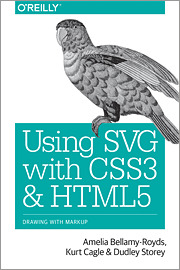Description
Using SVG with CSS3 and HTML5
Vector Graphics for Web Design
Authors: Bellamy–royds Amelia, Cagle Kurt, Storey Dudley
Language: English
Subjects for Using SVG with CSS3 and HTML5:
Approximative price 72.61 €
In Print (Delivery period: 14 days).
Add to cart818 p. · 15.8x22.8 cm · Paperback
Description
/li>Contents
/li>
Unlike other image formats, SVG can be an interactive part of your web site, integrated in HTML5 markup or created dynamically using JavaScript. It can be styled by CSS to instantly adapt to changes in your site's design. Flexible metadata options can make the graphics accessible to screen readers and search engines. And it is always displayed at the highest resolution possible, without requiring larger file sizes, making it ideal for both widescreen desktop displays and Retina mobile devices.
Using SVG with CSS3 and HTML5 starts with the basics, explaining how simple shapes and icons are defined in SVG, and then builds upon that foundation to create complex graphics and interactive, animated applications. It covers all the features you're likely to come across in web design, while avoiding areas with poor browser support.
- Chapter 2 - The Big Picture
- Chapter 3 - A Sense of Style
- Chapter 4 - Tools of the Trade
- Chapter 5 - Building Blocks
- Chapter 6 - Following Your Own Path
- Chapter 7 - The Art of the Word
- Chapter 8 - Scaling Up
- Chapter 9 - A New Point of View
- Chapter 10 - Seeing Double
- Chapter 11 - Transformative Changes
- >Chapter 12 - Coloring the Shapes
- Chapter 13 - Drawing the Lines
- Chapter 14 - Marking the Way
- Chapter 15 - Layered Looks
- Chapter 16 - Less Is More
- Chapter 17 - Playing with Pixels
- Chapter 18 - Beyond the Visible
- Chapter 19 - Drawing on Demand
- Chapter 20 - Good Manners
- Appendix A - SVG Style Properties
These books may interest you

HTML5 Graphics with SVG and CSS3 26.83 €



